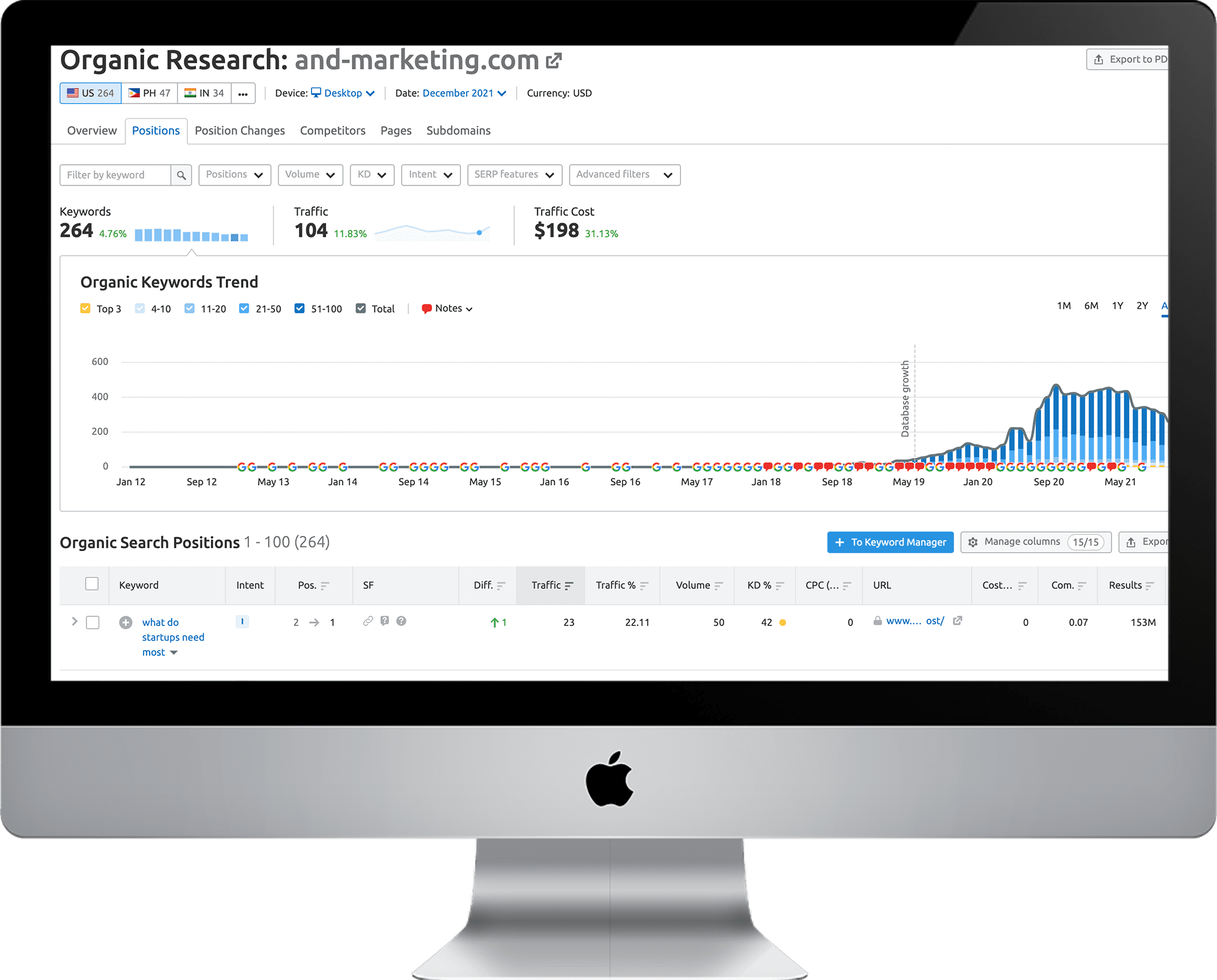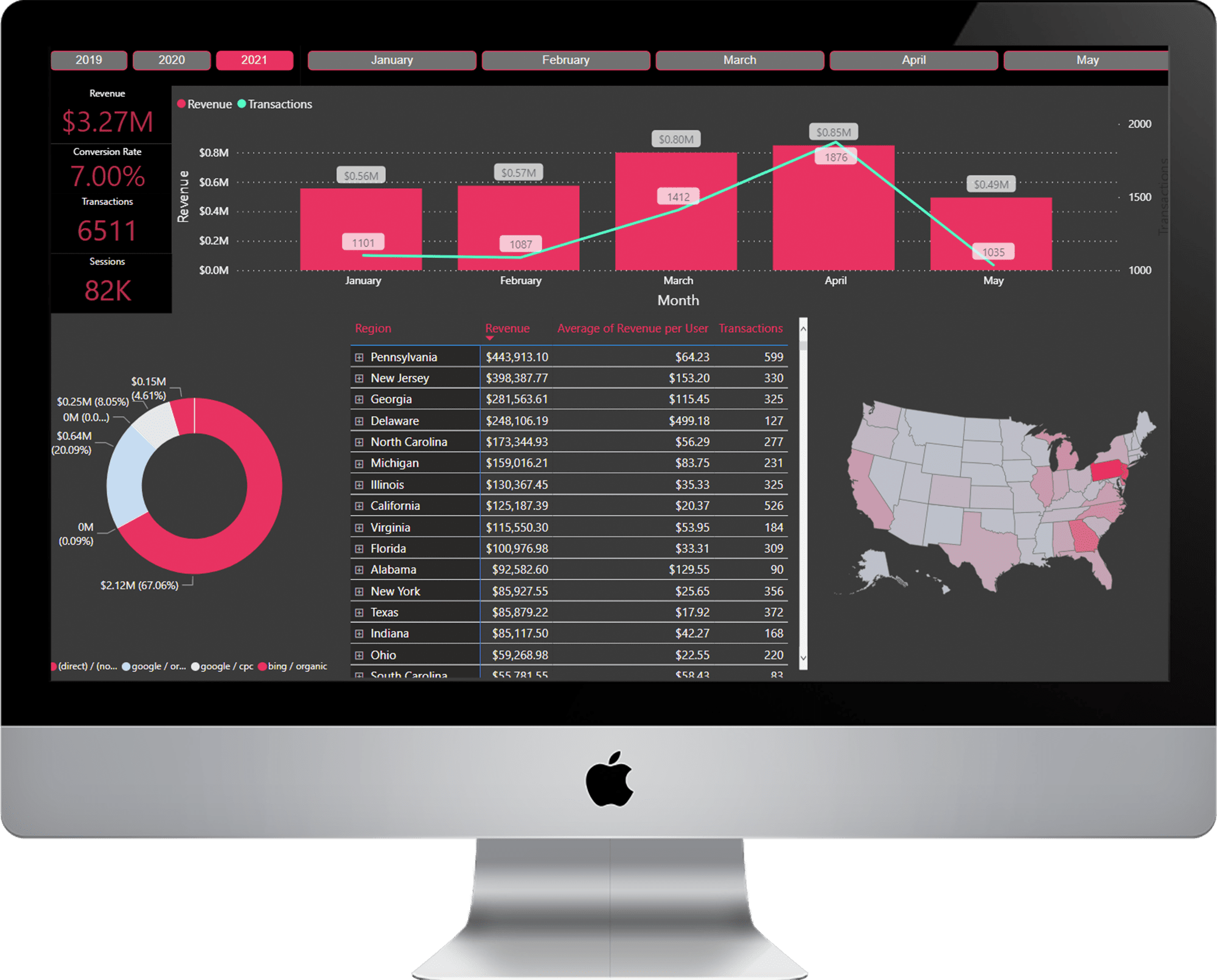All of the marketing trends with none of the industry jargon.
Sign up for our newsletter to stay updated on best practices, actionable tips, and virtual events so you can grow your business like a marketing pro.
"*" indicates required fields


Big data is hard to collect, organize, and view at scale, but you know you need it to compete in today’s growing digital landscape.The way you’re analyzing data now is likely a time-eating process that hardly ever results in quality business insights. It’s difficult to move beyond massive Excel spreadsheets, but it’s also daunting to invest in sophisticated tools that aggregate data but don’t integrate with one another. Telling a story through data pulled this way that can actually inform your business decisions is nearly impossible.
In order to remain digitally relevant, you must implement a solid business intelligence strategy that simplifies the ability to make business decisions from loads of data. In this blog, we discuss three ways business intelligence (BI) can form your business strategy for immediate success.
A business intelligence strategy is the process of developing and executing a BI system that will help identify opportunities and weaknesses that give your business a roadmap for achieving business level goals.
A BI strategy will help you make informed strategic decisions, save time and money, and gain a competitive edge. Implementing a BI strategy is not an easy task: it requires significant preparation and, potentially, expenses. In the end, though, the rewards (and ROI) will outway the costs. And soon, businesses that don’t BI will experience higher costs long term than those that do. Once the automations and aggregators are set up behind the scenes, you can cut the time it takes to manually pull, align, and analyze data manually by up to 90%.
A solidified BI strategy uncovers where your business is maximizing ROI while also identifying the business actions not giving you a return on your investment. It’s difficult to analyze ROI across business campaigns, most often due to unstructured data coming from multiple data sources that do not talk to each other. The information in these disparate systems may be easy to report on in a siloed view; however, a siloed view limits the ability to compare the real impact (or lack thereof) of a specific campaign. By implementing a BI strategy, CEOs and business owners can review data combined from multiple sources and see insights at the business level to fully understand what’s performing and what’s not.
BI can simplify the data collection process, which can reduce your long term costs for gathering data on an ongoing basis. Budgeting and forecasting can also be accomplished through a solid BI strategy. CEOs and business owners can estimate how much they need to spend on certain campaigns in order to achieve their business revenue goals with campaign-specific performance data. Additionally, they can quickly identify where campaigns are blowing through budget without producing results and take immediate action to either stop or reroute budget elsewhere.
Outgoing campaigns are not the only area where you can use BI to optimize your costs. At &Marketing, we use it internally to understand how we are spending our time for each of our clients and identify where we can improve our own execution processes to optimize time and reduce costs.
By implementing a business intelligence strategy, you can get visibility into your entire competitive landscape across multiple business lines and channels. Competitor intelligence is often difficult to work into existing analytics, as competitor data does not always match up apples to apples with your own data. If you’re struggling with limited competitor information, BI tools are available that can analyze competitor campaigns by identifying where they are doing better and what areas you can improve and overtake them.
Creating and executing a business intelligence strategy is not an easy task. It requires extensive planning and is not as easy as simply choosing a platform. Here’s what to know:
The most important part of creating a business intelligence strategy is to define KPIs for your business. Without KPIs, you will develop a strategy that does not effectively answer the questions you need to answer.
After defining your KPIs, understand the people, processes and technologies you need in order to achieve success. This step is important in getting everyone on the same page before getting too far down the road.
This is the most time-consuming step of creating a business intelligence strategy. You must gather all of the data and determine common connectors so it all communicates. Once you have aligned data sources, be sure to visualize the data in a way that CEOs and business leaders are able to easily understand.
This is the most exciting part of creating a business intelligence strategy and a critical step in taking data all the way from insights to action. Our team recommends reviewing data for multiple time frames in order to best understand your business. For example, compare months, quarters, and years to uncover trends. September might show higher numbers than October, but you might be up for the quarter or the previous year’s September.
Using the business insights from above, create a roadmap for success that details your campaigns. Use the roadmap to guide your tactics and serve as a baseline. After starting the campaigns, be sure to monitor results as soon as you have them.
Business intelligence strategies are always evolving, just as new digital tools arrive to market every day and online trends ebb and flow. Be sure to constantly review the market for ways to innovate.
Implementing a BI strategy requires upfront work and expense that your business will need to prepare for ahead of time. Yet, a solidified BI strategy uncovers where your business is maximizing ROI while also identifying the business actions not giving you a return on your investment.
Having trouble with building your BI strategy? Download Our BI eBook to help you pave a roadmap for your own business.
Marketing Director Paul Ferguson helps clients develop fully integrated marketing solutions that make impressions and drive results. Whether it be design-oriented campaigns or digital market execution, Paul skillfully creates strategies to effectively reach client’s desired audiences.
&Marketing provides the robust outsourced marketing department growing companies need without the high overhead costs of big agencies or full-time employees. Our variable model empowers businesses to reach their growth goals through access to the guidance and expertise of senior level strategists and a flexible execution team.
Are you facing challenges of your own in generating leads and meeting your business’ growth goals?
We’d love to learn more about your challenges and how a coordinated marketing approach might help take your organization to the next level.


Marketing budgets vary drastically by industry and there’s no one single formula to perfect budgeting. Even within the same industry, each business has its own nuisances—like company structure, goals, and customer journey (also known as the sales and marketing funnel). This doesn’t even include the one-off events and ideas that come up halfway through the year or the fourth quarter blitz many businesses perform surrounding the holidays.
Allocating your budget in the wrong places will lead to spending too much in certain areas and potentially running out of funds. Setting your budget too low will lead to poor results and a likely poor return on investment (ROI). The bottom line is, there’s no perfect system or cookie cutter template for a marketing budget that can apply to everyone.
In order to set the right budget and use it effectively, you need to:
Keep reading to dig a little deeper into the three steps above.
(Curious how much you should be budgeting? Check out our marketing budget calculator.)
A marketing budget is an estimate of costs related to marketing your products or services. A typical marketing budget takes into account all overhead marketing costs (ex: software, salaries for marketing employees, cost of office space). However, much of the budget is concerned with actual marketing communications and campaign efforts like public relations, website development and hosting, advertising, etc.
A marketing budget plan will help you put your marketing funds in the right place. When you know how much you can spend, you know how much you can put into each marketing strategy and channel. It allows you to determine which approaches work with your budget or if an outsourced digital marketing company’s packages fit within your budget. But before you create your marketing budget, there are a few foundational steps to take:
When you set your business’s goals, make sure they’re SMART goals (specific, measurable, achievable, relevant, and time-bound). You don’t want to set a goal like “increase sales.” It won’t give you a precise target to work towards and achieve. Instead, set a goal like “Increase sales by 20% by the end of the year.” This goal is easily measurable and gives your team something precise to achieve.
SMART goals will give you a concrete reference point when budgeting for marketing because all activities can be measured by milestones that work toward a specific revenue goal.
Perform a competitor analysis to see how your top competition performs online. While you’re at it, perform some market research and aggregate all the places your ideal customer hangs out online and plan how much it might cost to get your message and offer in front of them. You can even use some top-notch tools to get this information quickly and easily.
If you want to know how to prepare a marketing budget, start by establishing your external costs. You need to know the price tag attached to everything your company needs to succeed so you know how much you can allocate for marketing. Not only does it determine what services you can invest in, but it also helps you set a baseline for your ROI. Examples include:
Develop an idea of which strategies you want to use for your business when creating a marketing budget. When you know which strategies you want to invest in, you can determine how they will fit into your marketing budget plan. For example, do you want a robust content marketing plan that includes blogs and ebooks? What about email automation? Social media? Influencers? Be mindful not to try and do too many things at once, and always have a way to measure the strategy against the goals you set above.
Budgets are not unchangeable plans—they’re allotments you can tweak when you need to. Business changes throughout the year based on trends, seasonality, the economy, and other unpredictable factors. Budgets, like strategies, must be adjusted at any time.
The U.S. Small Business Administration recommends small businesses (businesses with revenue less than 5 million) allocate between 7% and 8% of total revenue to marketing — assuming your business has margins in the range of 10-12 percent. The number goes up from there for smaller businesses.
The amount of revenue businesses typically allocate to marketing has increased steadily over the past 10 years, with average marketing percentage of revenue landing around 13% in 2021, compared to just 8% back in 2011.
Try out our marketing budget calculator and see how much you should be preparing for your marketing budget!
Want to talk to someone on our team about how to put that marketing budget to use? Just fill out the form below and we’ll reach out to connect.
Marketing Director Paul Ferguson helps clients develop fully integrated marketing solutions that make impressions and drive results. Whether it be design-oriented campaigns or digital market execution, Paul skillfully creates strategies to effectively reach client’s desired audiences.
&Marketing provides the robust outsourced marketing department growing companies need without the high overhead costs of big agencies or full-time employees. Our variable model empowers businesses to reach their growth goals through access to the guidance and expertise of senior level strategists and a flexible execution team.
Are you facing challenges of your own in generating leads and meeting your business’ growth goals?
We’d love to learn more about your challenges and how a coordinated marketing approach might help take your organization to the next level.


Now more than ever, marketers have a wealth of tools and data designed to help us not only understand our audience better, but uncover where that audience is living online and what they are actively searching for. This knowledge is vital for marketing strategies designed to meet overall business goals.
Yet, with all this information on-hand and all the tools available to mine that data, many companies today are just revising marketing efforts made popular in the late ‘90s and early ‘00s; which relied on broadly plastering your message or creative assets to as many people as possible and see what sticks.
While you might generate some leads and back into your business goals with this approach, you’ll likely just be wasting time and money when you could be working smarter, not harder.
However, with all of the tools and data out there, it can be overwhelming or down right impossible to even know where to begin and how to leverage all of these glorious resources. Therefore, we’re going to help you find the elusive needle in the hay sack and show you three tools &Marketing leverages to save time, stop guessing, and still generate big results for our clients (and ourselves).
What is it?: Get measurable results from online marketing. Do SEO, content marketing, competitor research, PPC and social media marketing from just one platform. Data is good. Strategy is better. SEMRush gives you both. SEMRush knows a lot about your market and website. It gives you access to the world’s largest database of 20 billion keywords, 310 million ads, and 17 billion URLs crawled per day (“crawled” is a little jargon that means discovering and indexing content) .
But you get more than just numbers. SEMRush analyzes the data for you and gives you instant recommendations on SEO, content marketing and advertising that can help you improve your online visibility in days.
What it’s good for: SEMRush is great for obtaining a full listing of organic keywords that you and your competitors rank for, as well as an idea of how much traffic those terms bring to your site. SEMRush also breaks down competitors’ PPC efforts and acquisition sources. Additionally, SEMRush has recently rolled out a new feature that breaks down keyword intent, which will help you understand the gaps in your content. Lastly, SEMRush does a great job of auditing your website to identify SEO errors and challenges.
How we use it: &Marketing uses SEMRush to back up our organic data, analyze competitors organic and paid search presence research, as well as technical SEO website audits.

An example of a SEMRush Search
What is it?: Google SERP (Search Engine Results Page) tracking for anyone! With large-scale rank tracking and SERP analytics, you’re always the first with the answer to what’s happening on the SERPs. Not only will you be able to generate and monitor organic results, you’ll be able to uncover unknown competitors, content topics, related terms, and more!
What it’s good for: GetStat, founded by Moz, is an excellent tool to track keywords you currently rank for and to generate high level insights on the domains that are ranking for them and all of their related searches…at scale. Imagine having to look up 100 keywords and determining how many related searches there are for each one, how many questions people are asking about each one, and what the top 20 domains that are ranking for each one. GetStat gives you all of that data at scale.
How we use it: GetStat is a great tool to track and monitor keywords we’re looking to target. Additionally, GetStat allows us to generate reports, at scale, of the Top 20 listings, all of the People Also Ask questions (that little box on the first page of Google that tells you what else people are asking about a search query), all of the related searches, and all of the SERP features for ALL tracked keywords.

An example of a Top 20 Dashboard report from GetStat
What is it?: Audience Research. Solved. Forget expensive surveys or inaccurate, manual research. SparkToro finds the websites your customers visit, social accounts they follow, hashtags they use, and more — so you can actually get to know your target audience and do marketing that works.
Over 1,100 marketing agencies, content teams, PR leaders, and market researchers use SparkToro.
What it’s good for: SparkToro is an excellent resource for audience research. Simply type in a phrase that users have in their profile or commonly use, or a website they frequently visit. Then you’re able to uncover demographic information about people who fit that profile, websites they visit, podcasts they listen to, social accounts they follow, and press accounts they trust.
How we use it: We use SparkToro for audience research on our key decision makers. This tool helps us find commonalities in demographics and information consumption across multiple decision makers and helps us form strategies to best reach those audiences.

An example of a SparkToro Search
These are just a few of the tools we use when we perform a comprehensive Business Intelligence project. The best thing about these tools is that they allow us to export data that can be aligned with one another in data visualization programs like Power BI or Tableau. Once we have all of our data, we can develop dashboards within Power BI or Tableau, that allow us to easily navigate it and help us uncover powerful insights. No more messy excel files and pivot tables and VLookUps. Just clean, easy to read dashboards with data sets that can interact with one another and be easily mined. These insights inform the creation of a successful marketing roadmap so we know the exact steps to take to help our unique clients reach their business goals.

Example of an eCommerce Dashboard
Interested in learning more about our Business Intelligence and Analytics practice and how it can help drive your business and marketing strategy? Check out our Business Intelligence eBook to understand how this powerful process can grow your business.
Marketing Director Paul Ferguson helps clients develop fully integrated marketing solutions that make impressions and drive results. Whether it be design-oriented campaigns or digital market execution, Paul skillfully creates strategies to effectively reach client’s desired audiences. Follow Paul on LinkedIn.
&Marketing provides the robust outsourced marketing department growing companies need without the high overhead costs of big agencies or full-time employees. Our variable model empowers businesses to reach their growth goals through access to the guidance and expertise of senior level strategists and a flexible execution team.
Are you facing challenges of your own in generating leads and meeting your business’ growth goals?
We’d love to learn more about your challenges and how a coordinated marketing approach might help take your organization to the next level.


When times get tough and budgets are tight, growing businesses are often quick to dub marketing as nonessential, making it one of the first things to go. Based on our experience, this is due to a common misperception that marketing is an expense, not an investment. However, many of these same companies are under pressure to improve customer acquisition, which is an uphill battle without a strategic marketing lead generation plan in place.
In an age of instant gratification, folks often immediately make cuts to the efforts that have slowburn success because they don’t see enough quick wins and immediate return on investments. Hitting all the right touch points and building relationships takes time, but when time equals money, business often make knee-jerk decisions to slash marketing budgets first.
Because marketing is an investment, not an expense, you can’t realize its full value based on short-term tactics and quick wins. But as we approach the end of the year, many companies are looking more at inbound marketing and trying to decide how to best invest their dollars for longterm success (spoiler alert: content is still king as 70% of marketers are actively investing in it). If you are working with minimal resources but know some of those resources need to be invested in marketing efforts, we have some low-budget ways you can improve your current marketing lead generation strategy. These three ways include: honing your strategy, leveraging content, and optimization through data.
Companies under a tight budget and timeline often make the mistake of skipping strategy and rushing right into tactics in their marketing lead generation efforts. Although perfection is the enemy of progress, preparation and thoughtfulness are not. Whether you’re trying to move quickly, do the bare minimum to preserve your budget, or a combination of the two, diving in blindly can lead to haphazard decision-making and will likely cost you more time and money down the road when you see minimal results and return. If it were that easy, everyone would be doing it, and everyone would be winning!
When you’re re-examining your strategy, take a closer look at who you’re trying to reach and how you can get in front of your ideal, target customer or client. A few things to consider when doing this are:
The more you know about your audience, the more you can grow it and convert it. Market and competitor research can help you understand what pains your target decision makers are experiencing and what solutions they’re currently looking for to help ease those pains. Use free tools like SEMRush and UberSuggest to help you identify actual terms your audience is looking for on Google, and poll your existing audience or survey your current customers to find out what’s on their mind. A short and scrappy Google Form can work wonders and doesn’t cost a thing.
Knowing what to say to your audience is only half the battle. The other half is figuring out where to reach them. With a tight budget you may need to prioritize just one or two marketing channels to test, so it’s important to do a bit of research to make an informed decision on which channels will yield the best results. Does your existing content get more engagement via email or social media? Does your target audience use one social media platform more than another? You can use your own native analytics and data to help answer these questions (more on that later). For example, when doing this for one of our clients, we uncovered that they had a high email conversation rate despite only sending out occasional emails. By increasing their email cadence, we quickly increased conversions.
If you want to take this a step further, consider a tool we love called SparkToro, which dives deeper into demographic data and shows you:
If you want to go to the very next level, check out &Marketing’s Business Intelligence and Analytics (B.I.) projects. Our B.I. projects are designed to identify where your audience is most likely to discover information about and related to your business and then create a marketing roadmap
Now that you’ve zeroed in on your most engaged audience, their pain points and interests, and where they get their information, it’s time to start applying that knowledge. Here’s how:
Hone in on your value proposition and key messaging specific to the audience you identified as most engaged. By referring to the patterns you identified above, rework your value prop and your brand messaging based on the pain points most relevant to them. This will ensure your message to them is relevant and consistent across all of your marketing materials and the channels you use. Make sure your brand persona and identity aligns with the kind of voice your audience is most likely to seek and trust—you can learn more about that here.
Before creating new content, consider what you already have. Do you have old blogs, eBooks, or landing pages that speak to trending topics in your industry and the priority pain points you uncovered? Start repromoting this content via the channels you identified earlier. For blog posts in particular, ensure you optimize them for marketing lead generation by adding a clear call-to-action. Readers need to be directed to make a move once they finish consuming your content. Make sure your calls to action make sense, and provide both a primary and transitional option for each content piece.
Use your research to identify topics that would resonate most with your audience. Be strategic about the content you create and give your audience a pathway that leads them on a journey straight to your services or products as their solution. You can do this using the traditional marketing funnel, which categorizes content as:
We’ve put together a robust eBook on exactly how to be intentional about creating continue that actually helps you grow your business. See how we’re practicing what we preach here?
The more data you have, the more you learn about your audience, and the better you can cater your content and overall marketing to their needs. By reviewing native analytics and data from your email marketing, website, or social media platforms, you can determine which of your existing customers or prospects are most engaged with your brand.
From there, you can identify valuable patterns. Does your most engaged audience share similar demographic information? Are certain pages of your website receiving the most traffic? Is your audience clicking primarily on top-funnel content (content focused more broadly on a pain point versus your company)? Or are they actively engaged with bottom-funnel content (case studies, free demos, company video tutorials, etc)?
Sometimes you have to throw marketing spaghetti at the wall to see what sticks, but at a certain point you need to study what stuck and what didn’t to figure out where to continue to spend your limited resources. Rely on your data to tell you a story, let it speak to you, and listen. Then shuffle your dollars around to learn into what’s working and step back from what isn’t.
Ready to implement some of these low-cost strategies for marketing lead generation in the new year? Grab our marketing planning workbook below to help you get started.
We also recently held a webinar with an expert panel where we discuss how you can develop a marketing strategy that directly aligns with your business goals. You can watch the replay here
Want to talk to someone on our team about how you can put all of these ideas into practice? Just fill out the form below.
Marketing Director Paul Ferguson helps clients develop fully integrated marketing solutions that make impressions and drive results. Whether it be design-oriented campaigns or digital market execution, Paul skillfully creates strategies to effectively reach client’s desired audiences. Follow Paul on LinkedIn.
&Marketing provides the robust outsourced marketing department growing companies need without the high overhead costs of big agencies or full-time employees. Our variable model empowers businesses to reach their growth goals through access to the guidance and expertise of senior level strategists and a flexible execution team.
Are you facing challenges of your own in generating leads and meeting your business’ growth goals?
We’d love to learn more about your challenges and how a coordinated marketing approach might help take your organization to the next level.


On September 29, 2021 Google announced major updates to its search engine platform and Search Engine Result Page (SERP) features coming in the weeks and months ahead. Like most things in life, Google is ever evolving their platforms to offer users the best experience and help them easily discover the most relevant information while searching. While the user benefits greatly, many businesses must learn to adapt their content and SEO strategies in order to take advantage of the latest and greatest features being launched.
Google was able to initiate and fast track these new features because they have been utilizing their Multitask Unified Model, (MUM for short), an AI system, to help them understand search information and intent. The information MUM has provided is the foundation of some awesome new Google SERP features being rolled out.
“We’ve been experimenting with using MUM’s capabilities to make our products more helpful and enable entirely new ways to search. These new features are the latest steps we’re taking to make searching more natural and intuitive.”
In short, MUM helps Google understand how to simplify searches based on user intent. It’s multimodal, which means it can understand information from different formats like webpages, pictures, and more—simultaneously.
Some of the new features being rolled out for MUM include:
It appears Google is leaning heavily into more visual based searches. Although it remains to be seen how business can take advantage of these new features, we’re certain there will be opportunities to enhance your content, your site, and your products/product descriptions/feeds to highlight your business through these new features.
Google’s core mission is to connect people to information, and these new announcements are all about enabling users to find exactly what they are looking for more easily. What’s more, is Google is continuing to refine and provide new, intuitive ways for users to search. These features may present businesses with the opportunity to get in front of users by connecting a search to another related search, making it crucial for you and your business to properly set up and categorize content.
If Google makes the data available for exactly what features searchers are using to find and visit your website or content (such as “refine this search” or “people also ask”), you’ll be able to gather insights you can leverage to optimize your customer journey and better learn how to reach your target audiences.
As more information becomes available, it will be interesting to see if certain schema (or structured data) codes will be needed to add this functionality on your site and search listings in order to make the most out of the new visibility opportunities these features have to offer. Be sure to continue to follow our blog for the latest information as we these details unfold.
In the meantime, you can learn more about how all of this data should be used as your compass to direct your marketing roadmap through our Business Intelligence & Analytics eBook.
Reach out to our team with any questions you have about the new Google SERP features, your own analytics, or how to use them to make decisions and create content your audience is looking for.
Marketing Director Paul Ferguson helps clients develop fully integrated marketing solutions that make impressions and drive results. Whether it be design-oriented campaigns or digital market execution, Paul skillfully creates strategies to effectively reach client’s desired audiences. Follow Paul on LinkedIn.
&Marketing provides the robust outsourced marketing department growing companies need without the high overhead costs of big agencies or full-time employees. Our variable model empowers businesses to reach their growth goals through access to the guidance and expertise of senior level strategists and a flexible execution team.
Recent Comments